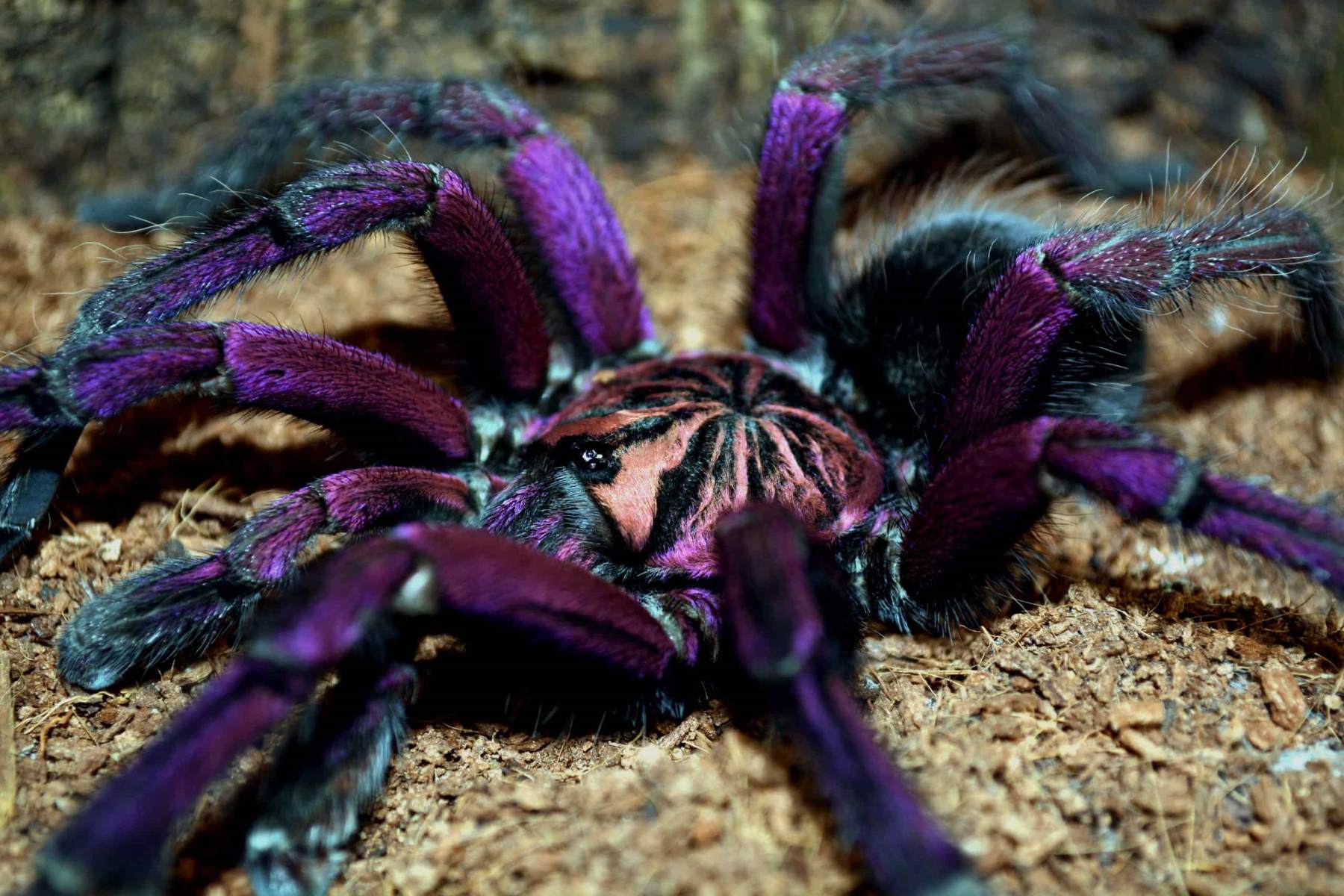
The Purple Bloom Tarantula, also known as the Gooty Sapphire Ornamental, is a stunning and captivating arachnid species that has captured the fascination of animal enthusiasts around the world. With its vibrant blue and purple hues, intricate patterns, and unique behavioral traits, it is no wonder that the Purple Bloom Tarantula has become a sought-after exotic pet.In this article, we will delve deeper into the intriguing world of the Purple Bloom Tarantula and uncover 17 fascinating facts about this remarkable creature. From its natural habitat to its striking appearance, mating rituals, and venomous capabilities, there’s much to learn and appreciate about this colorful and enigmatic spider.So, prepare to be amazed as we unravel the secrets and mystique surrounding the Purple Bloom Tarantula, shedding light on its intriguing biology, behavior, and characteristics.
Key Takeaways:
- The Purple Bloom Tarantula, native to South American rainforests, is a captivating species known for its vibrant purple color, impressive size, and unique behaviors. It plays a crucial role in maintaining ecosystem balance.
- Despite its intimidating appearance, the Purple Bloom Tarantula is relatively harmless to humans and primarily uses its venom to subdue prey. It is a sought-after species among tarantula enthusiasts for its captivating features.
The Purple Bloom Tarantula is native to the rainforests of South America.
The Purple Bloom Tarantula, scientifically known as Avicularia purpurea, is a species of tarantula that is found in the lush rainforests of South America. Its vibrant purple coloration sets it apart from other tarantula species, making it a popular choice among tarantula enthusiasts.
This tarantula gets its unique name from the beautiful purple flowers that bloom in its natural habitat.
The Purple Bloom Tarantula derives its name from the stunning purple flowers that bloom in the same areas where it is found. These colorful blooms create a visually captivating setting for this remarkable creature.
It is one of the largest arboreal tarantula species, with a leg span of up to 8 inches.
The Purple Bloom Tarantula holds the distinction of being one of the largest arboreal tarantula species. With a leg span that can reach up to 8 inches, it commands attention with its impressive size and presence.
This species of tarantula does not pose a significant threat to humans.
Despite its intimidating appearance, the Purple Bloom Tarantula is relatively harmless to humans. While its bite can cause discomfort and irritation, it is not considered venomous or dangerous.
Female Purple Bloom Tarantulas generally live longer than males.
In the world of tarantulas, female specimens typically have longer lifespans compared to males. Female Purple Bloom Tarantulas can live up to 20 years, while males have a shorter lifespan of around 5-7 years.
The Purple Bloom Tarantula is known for its unique defensive behavior known as “urticating hairs.”
When threatened, Purple Bloom Tarantulas have the ability to kick off tiny barbed hairs from their abdomen, causing irritation and discomfort to potential predators. This defense mechanism serves as a deterrent and allows the tarantula to escape from danger.
It constructs elaborate silk-lined burrows in trees.
The Purple Bloom Tarantula is known for its impressive burrowing skills. It constructs intricate tunnels within tree trunks or branches, which are lined with silk for added stability and insulation. These burrows provide the tarantula with a secure hiding place and a comfortable home.
Their purple coloration serves as a form of camouflage.
The vibrant purple color of the Purple Bloom Tarantula helps it blend in with the colorful flora of its natural habitat. This allows the tarantula to remain hidden from potential predators and increases its chances of survival.
Purple Bloom Tarantulas are primarily nocturnal creatures.
Like many other tarantula species, the Purple Bloom Tarantula is most active during the night. Under the cover of darkness, it ventures out of its burrow to hunt for prey and carry out other essential activities.
They primarily feed on insects and small invertebrates.
The Purple Bloom Tarantula is a carnivorous predator, with insects and small invertebrates forming the bulk of its diet. It uses its powerful fangs to capture and immobilize its prey before consuming it.
During mating, the male performs a complex courtship dance to woo the female.
Male Purple Bloom Tarantulas go through a fascinating courtship ritual to attract a female mate. They employ intricate movements and drumming sounds to impress the female and secure a successful mating encounter.
The female lays egg sacs containing hundreds of eggs.
After successful mating, the female Purple Bloom Tarantula will lay egg sacs that contain hundreds of eggs. She diligently guards and protects the sac until the spiderlings emerge.
Spiderlings undergo multiple molts to reach their adult size.
After hatching from the egg sac, the spiderlings go through a series of molts or shedding of their exoskeleton to grow and develop. This process continues until they reach their full adult size.
Purple Bloom Tarantulas have specialized feet for gripping onto surfaces.
To navigate their arboreal habitat effectively, Purple Bloom Tarantulas have evolved specialized feet with tiny claws. These claws allow them to grip onto various surfaces, such as tree bark, with ease and agility.
Their venom is primarily used for subduing prey rather than for self-defense.
While the Purple Bloom Tarantula possesses venom, it primarily uses it to immobilize its prey before consuming them. The venom is not potent enough to be a significant threat to humans.
These tarantulas have an important role in maintaining ecosystem balance.
As predators, Purple Bloom Tarantulas play a vital role in controlling populations of insects and small invertebrates in their ecosystem. By regulating these populations, they contribute to maintaining the overall balance of the natural environment.
Purple Bloom Tarantulas are in high demand among tarantula enthusiasts.
The unique combination of their vibrant purple coloration, impressive size, and intriguing behaviors make Purple Bloom Tarantulas highly sought-after by tarantula enthusiasts. Many collectors and hobbyists find these captivating creatures to be a prized addition to their collections.
Conclusion
In conclusion, the Purple Bloom Tarantula is a fascinating creature that captivates us with its vibrant color and unique characteristics. From its stunning purple hue to its intricate web-spinning abilities, this tarantula is truly a marvel of nature. Whether you’re a tarantula enthusiast or simply intrigued by the wonders of the animal kingdom, learning about the Purple Bloom Tarantula is sure to leave you in awe.
FAQs
Q: Where can the Purple Bloom Tarantula be found?
A: The Purple Bloom Tarantula is native to the rainforests of Southeast Asia, particularly in countries like Thailand and Malaysia.
Q: What makes the Purple Bloom Tarantula unique?
A: The most striking feature of the Purple Bloom Tarantula is its purple coloration, which is highly unusual for tarantulas. It also possesses intricate patterns on its body and long, hairy legs.
Q: What is the size of the Purple Bloom Tarantula?
A: Adult Purple Bloom Tarantulas can grow to a size of around 4 to 6 inches, with females being larger than males.
Q: What does the Purple Bloom Tarantula eat?
A: The Purple Bloom Tarantula primarily feeds on insects and small invertebrates. Their diet typically consists of crickets, moths, and other similar prey.
Q: Is the Purple Bloom Tarantula venomous?
A: Yes, like most tarantulas, the Purple Bloom Tarantula is venomous. However, its venom is not considered highly toxic to humans. It is primarily used to immobilize its prey.
Q: Do Purple Bloom Tarantulas make good pets?
A: Keeping a Purple Bloom Tarantula as a pet requires specific knowledge and experience in handling tarantulas. They have specific care requirements and a docile nature. It’s best to research and consult with experts before considering them as pets.
Q: How long do Purple Bloom Tarantulas live?
A: On average, the Purple Bloom Tarantula has a lifespan of 5 to 10 years, with females typically living longer than males.
Q: Are Purple Bloom Tarantulas aggressive?
A: The Purple Bloom Tarantula is not known to be aggressive and will usually retreat rather than attack. However, like all tarantulas, they may bite if provoked or feel threatened.
Q: Can the Purple Bloom Tarantula regenerate its legs?
A: Yes, if a Purple Bloom Tarantula loses a leg due to injury or self-defense, it has the ability to regenerate a new one during molting.
Q: Are Purple Bloom Tarantulas a protected species?
A: As of now, Purple Bloom Tarantulas are not classified as a protected species. However, due to habitat loss and collection for the exotic pet trade, their populations are declining, and efforts to conserve them are underway.
Was this page helpful?
Our commitment to delivering trustworthy and engaging content is at the heart of what we do. Each fact on our site is contributed by real users like you, bringing a wealth of diverse insights and information. To ensure the highest standards of accuracy and reliability, our dedicated editors meticulously review each submission. This process guarantees that the facts we share are not only fascinating but also credible. Trust in our commitment to quality and authenticity as you explore and learn with us.


